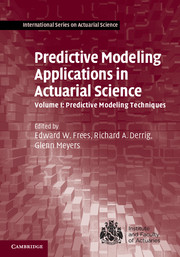Book contents
- Frontmatter
- Contents
- Contributor List
- Acknowledgments
- 1 Predictive Modeling in Actuarial Science
- II Predictive Modeling Foundations
- II Predictive Modeling Methods
- III Bayesian and Mixed Modeling
- 13 Bayesian Computational Methods
- 14 Bayesian Regression Models
- 15 Generalized Additive Models and Nonparametric Regression
- 16 Nonlinear Mixed Models
- IV Longitudinal Modeling
- Index
- References
13 - Bayesian Computational Methods
from III - Bayesian and Mixed Modeling
Published online by Cambridge University Press: 05 August 2014
- Frontmatter
- Contents
- Contributor List
- Acknowledgments
- 1 Predictive Modeling in Actuarial Science
- II Predictive Modeling Foundations
- II Predictive Modeling Methods
- III Bayesian and Mixed Modeling
- 13 Bayesian Computational Methods
- 14 Bayesian Regression Models
- 15 Generalized Additive Models and Nonparametric Regression
- 16 Nonlinear Mixed Models
- IV Longitudinal Modeling
- Index
- References
Summary
Chapter Preview. Bayesian methods have grown rapidly in popularity because of their general applicability, structured and direct incorporation of expert opinion, and proper accounting of model and parameter uncertainty. This chapter outlines the basic process and describes the benefits and difficulties inherent in fitting Bayesian models.
Why Bayesian?
Although the theory underpinning Bayesian methods is about 350 years old (Sir Thomas Bayes' essay was read to the Royal Society after his death; see Bayes and Price 1763), their widespread use was limited by computational power. In models of reasonable size and complexity, large iterated integrals need to be numerically approximated, which can be computationally burdensome. In the early 1990s the development of randomized algorithms to approximate these integrals, including the Gibbs sampler (Gelfand and Smith 1990), and the exponential growth of computing power made Bayesian methods accessible. More recently, with the development and growth of statistical software such as R, WinBUGS, and now PROC MCMC in SAS, Bayesian methods are available and employed by practitioners in many fields (see Albert 2009, for some details and examples). Actuaries have been using Bayesian methods since Whitney (1918) approximated them in a credibility framework. Unfortunately, many have been slow to extend them for use in other natural contexts. Among other benefits, Bayesian methods properly account for model and parameter uncertainty, provide a structure to incorporate expert opinion, and are generally applicable to many methods in this book and throughout the industry.
- Type
- Chapter
- Information
- Predictive Modeling Applications in Actuarial Science , pp. 315 - 333Publisher: Cambridge University PressPrint publication year: 2014

